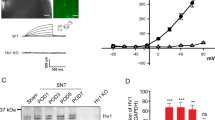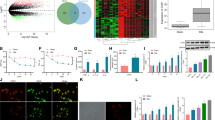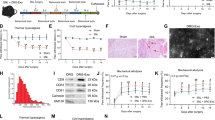Abstract
P2X4 receptors (P2X4Rs), a subtype of the purinergic P2X family, play important roles in regulating neuronal and glial functions in the nervous system. We have previously shown that the expression of P2X4Rs is upregulated in activated microglia after peripheral nerve injury and that activation of the receptors by extracellular ATP is crucial for maintaining nerve injury-induced pain hypersensitivity. However, the regulation of P2X4R expression on the cell surface of microglia is poorly understood. Here, we identify the CC chemokine receptor CCR2 as a regulator of P2X4R trafficking to the cell surface of microglia. In a quantitative cell surface biotinylation assay, we found that applying CCL2 or CCL12, endogenous ligands for CCR2, to primary cultured microglial cells, increased the levels of P2X4R protein on the cell surface without changing total cellular expression. This effect of CCL2 was prevented by an antagonist of CCR2. Time-lapse imaging of green fluorescent protein (GFP)-tagged P2X4R in living microglial cells showed that CCL2 stimulation increased the movement of P2X4R-GFP particles. The subcellular localization of P2X4R immunofluorescence was restricted to lysosomes around the perinuclear region. Notably, CCL2 changed the distribution of lysosomes with P2X4R immunofluorescence within microglial cells and induced release of the lysosomal enzyme β-hexosaminidase, indicating lysosomal exocytosis. Moreover, CCL2-stimulated microglia enhanced Akt phosphorylation by ATP applied extracellularly, a P2X4R-mediated response. These results indicate that CCL2 promotes expression of P2X4R protein on the cell surface of microglia through exocytosis of P2X4R-containing lysosomes, which may be a possible mechanism for pain hypersensitivity after nerve injury.







Similar content being viewed by others
References
Hanisch UK, Kettenmann H (2007) Microglia: active sensor and versatile effector cells in the normal and pathologic brain. Nat Neurosci 10:1387–1394
Streit WJ (2002) Microglia as neuroprotective, immunocompetent cells of the CNS. Glia 40:133–139
Prinz M, Mildner A (2011) Microglia in the CNS: immigrants from another world. Glia 59:177–187
Inoue K, Koizumi S, Tsuda M (2007) The role of nucleotides in the neuron–glia communication responsible for the brain functions. J Neurochem 102:1447–1458
Pocock JM, Kettenmann H (2007) Neurotransmitter receptors on microglia. Trends Neurosci 30:527–535
Tsuda M, Shigemoto-Mogami Y, Koizumi S et al (2003) P2X4 receptors induced in spinal microglia gate tactile allodynia after nerve injury. Nature 424:778–783
Cavaliere F, Florenzano F, Amadio S et al (2003) Up-regulation of P2X2, P2X4 receptor and ischemic cell death: prevention by P2 antagonists. Neuroscience 120:85–98
Guo LH, Trautmann K, Schluesener HJ (2004) Expression of P2X4 receptor in rat C6 glioma by tumor-associated macrophages and activated microglia. J Neuroimmunol 152:67–72
Guo LH, Trautmann K, Schluesener HJ (2005) Expression of P2X4 receptor by lesional activated microglia during formalin-induced inflammatory pain. J Neuroimmunol 163:120–127
Zhang Z, Zhang Z, Artelt M et al (2007) Dexamethasone attenuates early expression of three molecules associated with microglia/macrophages activation following rat traumatic brain injury. Acta Neuropathol 113:675–682
Schwab JM, Guo L, Schluesener HJ (2005) Spinal cord injury induces early and persistent lesional P2X4 receptor expression. J Neuroimmunol 163:185–189
Zhang Z, Zhang ZY, Fauser U et al (2008) Mechanical allodynia and spinal up-regulation of P2X4 receptor in experimental autoimmune neuritis rats. Neuroscience 152:495–501
Coull JA, Beggs S, Boudreau D et al (2005) BDNF from microglia causes the shift in neuronal anion gradient underlying neuropathic pain. Nature 438:1017–1021
Tsuda M, Inoue K, Salter MW (2005) Neuropathic pain and spinal microglia: a big problem from molecules in "small" glia. Trends Neurosci 28:101–107
Ohsawa K, Irino Y, Nakamura Y et al (2007) Involvement of P2X4 and P2Y12 receptors in ATP-induced microglial chemotaxis. Glia 55:604–616
Ohsawa K, Irino Y, Sanagi T et al (2010) P2Y12 receptor-mediated integrin-beta1 activation regulates microglial process extension induced by ATP. Glia 58:790–801
Wu LJ, Vadakkan KI, Zhuo M (2007) ATP-induced chemotaxis of microglial processes requires P2Y receptor-activated initiation of outward potassium currents. Glia 55:810–821
Charo IF, Myers SJ, Herman A et al (1994) Molecular cloning and functional expression of two monocyte chemoattractant protein 1 receptors reveals alternative splicing of the carboxyl-terminal tails. Proc Natl Acad Sci U S A 91:2752–2756
Boumechache M, Masin M, Edwardson JM et al (2009) Analysis of assembly and trafficking of native P2X4 and P2X7 receptor complexes in rodent immune cells. J Biol Chem 284:13446–13454
Tsuda M, Masuda T, Kitano J et al (2009) IFN-gamma receptor signaling mediates spinal microglia activation driving neuropathic pain. Proc Natl Acad Sci U S A 106:8032–8037
Nasu-Tada K, Koizumi S, Tsuda M et al (2006) Possible involvement of increase in spinal fibronectin following peripheral nerve injury in upregulation of microglial P2X4, a key molecule for mechanical allodynia. Glia 53:769–775
Tsuda M, Toyomitsu E, Kometani M et al (2009) Mechanisms underlying fibronectin-induced up-regulation of P2X4R expression in microglia: distinct roles of PI3K-Akt and MEK-ERK signalling pathways. J Cell Mol Med 13:3251–3259
Tsuda M, Toyomitsu E, Komatsu T et al (2008) Fibronectin/integrin system is involved in P2X(4) receptor upregulation in the spinal cord and neuropathic pain after nerve injury. Glia 56:579–585
Tsuda M, Tozaki-Saitoh H, Masuda T et al (2008) Lyn tyrosine kinase is required for P2X(4) receptor upregulation and neuropathic pain after peripheral nerve injury. Glia 56:50–58
Qureshi OS, Paramasivam A, Yu JC et al (2007) Regulation of P2X4 receptors by lysosomal targeting, glycan protection and exocytosis. J Cell Sci 120:3838–3849
Schwartz M, Butovsky O, Bruck W et al (2006) Microglial phenotype: is the commitment reversible? Trends Neurosci 29:68–74
Nakajima K, Shimojo M, Hamanoue M et al (1992) Identification of elastase as a secretory protease from cultured rat microglia. J Neurochem 58:1401–1408
Kuronita T, Eskelinen EL, Fujita H et al (2002) A role for the lysosomal membrane protein LGP85 in the biogenesis and maintenance of endosomal and lysosomal morphology. J Cell Sci 115:4117–4131
Mirzadegan T, Diehl F, Ebi B et al (2000) Identification of the binding site for a novel class of CCR2b chemokine receptor antagonists: binding to a common chemokine receptor motif within the helical bundle. J Biol Chem 275:25562–25571
Nanki T, Nagasaka K, Hayashida K et al (2001) Chemokines regulate IL-6 and IL-8 production by fibroblast-like synoviocytes from patients with rheumatoid arthritis. J Immunol 167:5381–5385
Jimenez-Sainz MC, Fast B, Mayor F Jr et al (2003) Signaling pathways for monocyte chemoattractant protein 1-mediated extracellular signal-regulated kinase activation. Mol Pharmacol 64:773–782
Myers SJ, Wong LM, Charo IF (1995) Signal transduction and ligand specificity of the human monocyte chemoattractant protein-1 receptor in transfected embryonic kidney cells. J Biol Chem 270:5786–5792
Wong LM, Myers SJ, Tsou CL et al (1997) Organization and differential expression of the human monocyte chemoattractant protein 1 receptor gene. Evidence for the role of the carboxyl-terminal tail in receptor trafficking. J Biol Chem 272:1038–1045
Sarafi MN, Garcia-Zepeda EA, MacLean JA et al (1997) Murine monocyte chemoattractant protein (MCP)-5: a novel CC chemokine that is a structural and functional homologue of human MCP-1. J Exp Med 185:99–109
Inoue K, Tsuda M (2009) Microglia and neuropathic pain. Glia 57:1469–1479
Royle SJ, Qureshi OS, Bobanovic LK et al (2005) Non-canonical YXXGPhi endocytic motifs: recognition by AP2 and preferential utilization in P2X4 receptors. J Cell Sci 118:3073–3080
Bobanovic LK, Royle SJ, Murrell-Lagnado RD (2002) P2X receptor trafficking in neurons is subunit specific. J Neurosci 22:4814–4824
Eskelinen EL, Tanaka Y, Saftig P (2003) At the acidic edge: emerging functions for lysosomal membrane proteins. Trends Cell Biol 13:137–145
Ulmann L, Hatcher JP, Hughes JP et al (2008) Up-regulation of P2X4 receptors in spinal microglia after peripheral nerve injury mediates BDNF release and neuropathic pain. J Neurosci 28:11263–11268
Burnstock G (2008) Purinergic signalling and disorders of the central nervous system. Nat Rev Drug Discov 7:575–590
Stokes L, Surprenant A (2009) Dynamic regulation of the P2X4 receptor in alveolar macrophages by phagocytosis and classical activation. Eur J Immunol 39:986–995
Toulme E, Garcia A, Samways D et al (2010) P2X4 receptors in activated C8-B4 cells of cerebellar microglial origin. J Gen Physiol 135:333–353
Van Steenwinckel J, Reaux-Le Goazigo A, Pommier B et al (2011) CCL2 released from neuronal synaptic vesicles in the spinal cord is a major mediator of local inflammation and pain after peripheral nerve injury. J Neurosci 31:5865–5875
Murrell-Lagnado RD, Qureshi OS (2008) Assembly and trafficking of P2X purinergic receptors (review). Mol Membr Biol 25:321–331
Colvin RA, Means TK, Diefenbach TJ et al (2010) Synaptotagmin-mediated vesicle fusion regulates cell migration. Nat Immunol 11:495–502
Czibener C, Sherer NM, Becker SM et al (2006) Ca2+ and synaptotagmin VII-dependent delivery of lysosomal membrane to nascent phagosomes. J Cell Biol 174:997–1007
Wu D, LaRosa GJ, Simon MI (1993) G protein-coupled signal transduction pathways for interleukin-8. Science 261:101–103
Kuehn HS, Gilfillan AM (2007) G protein-coupled receptors and the modification of FcepsilonRI-mediated mast cell activation. Immunol Lett 113:59–69
Serrano A, Pare M, McIntosh F et al (2010) Blocking spinal CCR2 with AZ889 reversed hyperalgesia in a model of neuropathic pain. Mol Pain 6:90
Old EA, Malcangio M (2011) Chemokine mediated neuron-glia communication and aberrant signalling in neuropathic pain states. Curr Opin Pharmacol (in press)
Terashima Y, Onai N, Murai M et al (2005) Pivotal function for cytoplasmic protein FROUNT in CCR2-mediated monocyte chemotaxis. Nat Immunol 6:827–835
Schilling M, Strecker JK, Ringelstein EB et al (2009) The role of CC chemokine receptor 2 on microglia activation and blood-borne cell recruitment after transient focal cerebral ischemia in mice. Brain Res 1289:79–84
Galasso JM, Stegman LD, Blaivas M et al (2000) Experimental gliosarcoma induces chemokine receptor expression in rat brain. Exp Neurol 161:85–95
Abbadie C, Bhangoo S, De Koninck Y et al (2009) Chemokines and pain mechanisms. Brain Res Rev 60:125–134
Abbadie C, Lindia JA, Cumiskey AM et al (2003) Impaired neuropathic pain responses in mice lacking the chemokine receptor CCR2. Proc Natl Acad Sci U S A 100:7947–7952
Wixey JA, Reinebrant HE, Carty ML et al (2009) Delayed P2X4R expression after hypoxia-ischemia is associated with microglia in the immature rat brain. J Neuroimmunol 212:35–43
Zhang J, Shi XQ, Echeverry S et al (2007) Expression of CCR2 in both resident and bone marrow-derived microglia plays a critical role in neuropathic pain. J Neurosci 27:12396–12406
Acknowledgments
This work was supported by grants from the Ministry of Education, Culture, Sports, Science and Technology of Japan (M.T., K.I.) and from the Core-to-Core program “Integrated Action Initiatives” of the Japan Society for the Promotion of Science (JSPS) (M.T., K.I.).
Author information
Authors and Affiliations
Corresponding author
Additional information
E. Toyomitsu and M. Tsuda are equally contributed to this work.
Rights and permissions
About this article
Cite this article
Toyomitsu, E., Tsuda, M., Yamashita, T. et al. CCL2 promotes P2X4 receptor trafficking to the cell surface of microglia. Purinergic Signalling 8, 301–310 (2012). https://doi.org/10.1007/s11302-011-9288-x
Received:
Accepted:
Published:
Issue Date:
DOI: https://doi.org/10.1007/s11302-011-9288-x




